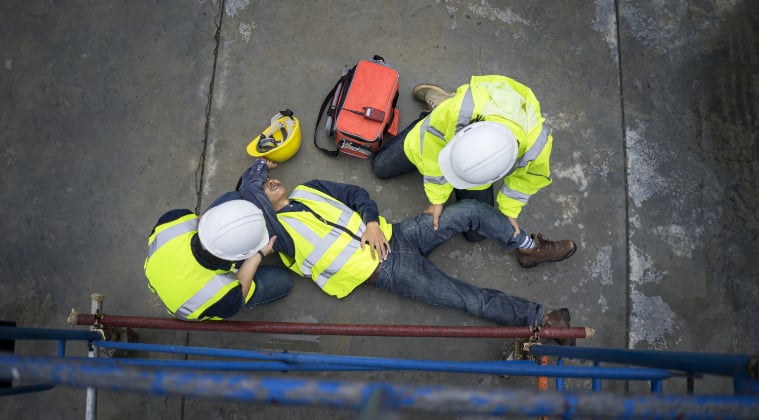
UPD 29/12/2022
We can dream about “zero incidents/accidents” at work in an ideal world. But unfortunately, this is not the case. According to the International Labor Organization (ILO), around 402 million occupational accidents and 189 million work-related illnesses are reported every year. Once an accident has occurred, what happens next? What are the procedures and actions put in place to prevent its reoccurrence?
The employer is legally obliged to guarantee the safety and health of their employees. But even when all the actions are well implemented to prevent any occupational accidents and incidents, sometimes hazardous situations occur. Therefore, companies rely on an effective incident management process, helping them to pursue their business operations without disruption.
What is incident management?
Incidents are unplanned hazardous events that can occur in the workplace leading to workers’ injuries or equipment damage. Also, they present good opportunities for companies to learn and enhance their performance and activities.
The incident management process is the set of actions and procedures to react to and resolve a hazardous event and prevent its recurrence in the future.
Some statistical data on occupational accidents and illnesses
Occupational accidents and diseases are a fact and all employers alongside their EHS department are always working to reduce these incidents to establish a healthier and more secure workplace. Here is some data about workplace injuries and illnesses in some parts of the world.
In general, the reported non-fatal and fatal workplace injuries and illnesses in the world showed a downward trend over the years.
The reporting of fatal accidents at work is much more difficult to avoid. The ILO reports that around 2.9 million people die each year as a result of occupational accidents and diseases. Companies around the world are working hard to reduce these fatal accidents. For example, in Great Britain, the rate of fatal injury per 100 000 workers has dropped from 1.10 in the early 2000s to 0.38 in 2021/2022, and there were 123 fatalities related to occupational accidents in 2022. Occupational accidents' downward trend is also observed in the EU countries throughout the last 12 years. But in the United States of America (USA), according to the bureau of labor statistics, the number of fatal accidents remains at around 5000 cases per year during the last 12 years. However, we must note the fact that the rate of fatal injuries in 2021 increased by around 8%.
As for the non-fatal incidents (injuries and illnesses) in the USA, around a 50% decrease in the non-fatal reported incidents was observed from the early 2000s until now. However, the situation in 2020 was exceptional, according to the bureau of labor statistics 33.2% of the illnesses cases reported were related to Covid-19. In 2021, we still notice a 52% increase in work-reported illnesses compared to the 2019 pre-Covid time. As for the reported injuries, there has been an 8% decrease when we compare the data between 2021 and 2019.
According to the Labour Force Survey (LFS), the same downward trend is observed for workplace non-fatal injuries in Great Britain. The reported workplace non-fatal injury dropped from around 4000 per 100,000 workers in 2000/01 to 1790 in 2021/22 (estimated statistics), around a 58% decrease. Compared to the 2021 results a small increase is observed due to the recovery of full business operations in 2022.
In general, the rate of reported illnesses in both the USA and Great Britain had been broadly flat over the years, without taking into consideration the Covid-19 crisis.
Every employer has to react and report each time there is an occupational accident. This includes numerous procedures from site investigation of the accident until putting in place the corrective and preventive actions. To do so, a company must have an effective incident management process.
Effective incident management aims to pursue corrective measures without letting the accident affect the performance and the activity of the company.
Discover the best Apps for your HSE management
What are the actions and procedures after an incident?
Once an incident occurs, the employee(s) should notify his/their manager. This leads to a chain of reactions leading to corrective actions.
Legal obligations of the parties concerned
The employer must report each occupational accident causing injuries and diseases to the workers. The employer should address a complete form to the health and safety department in his country. For example in Great Britain, thanks to the Reporting of Injuries, Diseases and Dangerous Occurrences Regulations (RIDDOR’s law), the employer’s duty is to report each occupational death, accident, and disease and keep the corresponding records. It is the same case for employers in the United States of America with the “OSHA Injury and Illness Recordkeeping and Reporting Requirements”.
Incident investigation and analysis
Each company has an incident response team or an incident management team. The team is composed of specific members designated by the company's internal organisation.
When an accident occurs, the investigation begins. Each company has its incident notification form to determine the severity of the accident. In addition, the company has an incident investigation form to investigate and well document each occurring accident.
Once all the data and the facts are gathered, they are analysed to determine the incident's root cause and the responsible(s). The intervention of the incident management team depends on the type of accident. If it’s minor (depending on the company’s risk and accident assessment), it can be resolved directly and easily without the escalation of the incident. In this case, no further actions are necessary.
Incident report
Once the investigation and the analysis are completed, the incident management team issues the final incident report. The report should mention all the details of the investigation and analysis methods (e.g. photographs and videos taken at the scene…), the identification of the incident cause and the takeaways.
To enhance the incident management process, digitised forms of incident notification and incident investigation could easily be used both in the office and in the field via smartphones and/or tablets. In addition, photos and videos of the inspected incident can be taken, add comments and insert this information to the investigation forms.
The final Business Intelligence report can be automatically generated and sent to all parties concerned. Furthermore, it can be accessed by all stakeholders wherever they are at any time. It will also allow good monitoring of the corrective and preventive actions implemented by the EHS team. In addition, all the old and new reports are stored safely on the platform and can be accessed and edited at all times.
Corrective and preventive actions (CAPA)
To prevent the reoccurrence of an incident, the EHS division of the company should go beyond the lessons and recommendations. The dissemination of the learned facts and the assignment of corrective and preventive actions are primordial to ensure continuous safety improvement. By doing so, new preventive measures are put in place in compliance with the regulations. In addition, a good training process for the employees can also contribute to the insurance of preventing the reoccurrence of the same accident.
Follow-ups
The corrective and preventive action plan should be monitored to ensure that all the measures are well implemented and completed as scheduled. The ending phase of the follow-up depends on the approval of the head of the EHS department and the director.
In addition, the review frequency of the corrective action plan should be established to confirm the effectiveness of the implemented measures.
In the procedure of incident management, exceptional cases, such as near-miss cases, could happen. In this type of incident, there are no injuries or damages to both the equipment or employees. However, they should not be treated lightly and corrective actions should take place.
Effective incident management aims to allow companies to pursue their activities without interruption and to allow a fast reaction to an incident. Moreover, to improve the identification of threats and effectively treat the resulting risks, companies can use ISO 31000 to enhance their performance and eventually achieve their objectives. Therefore combining the use of ISO 31000 and a good incident management process will allow you to save precious time and gain in performance.
To go further:
Ensure your incident management process with BlueKanGo’s digital platform and its app Compensation/Disability Administrative Management (available on BueKanGo’s Marketplace)
. . .





.jpg?width=169&name=unnamed%20(7).jpg)